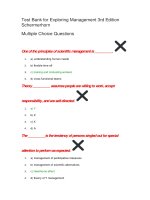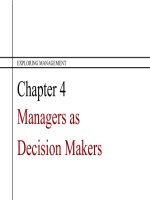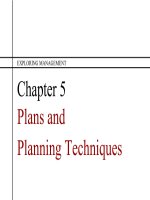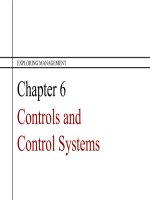Exploring management 3rd ch08
Bạn đang xem bản rút gọn của tài liệu. Xem và tải ngay bản đầy đủ của tài liệu tại đây (1.07 MB, 39 trang )
Exploring Management
Chapter 8
Organization Structure
and Design
Chapter 8
• What is organizing as a managerial
responsibility?
• What are the most common types of
organization structures?
• What are the trends in organizational
design?
8.1
Organizing
• Organizing is one of the management
functions
• Organization charts describe the formal
structures of organizations
• Organizations also operate with informal
structures
• Informal structures have good points and
bad points
ORGANIZING
Management Functions
• Organizing
– Arranges people and resources to work
toward a goal
ORGANIZING
Organizational Charts
• Structure
– system of tasks, reporting relationships,
and communication that links people
and positions within an organization.
• Organization Charts
– describe the formal structure, how an
organization should ideally work.
• The number of management layers from top to bottom.
Levels of management
Major subunits
• Which job titles are grouped together in work units,
departments, or divisions.
Staff positions
• Staff specialists that support other positions and parts of the
organization.
• Lines between positions show routes for formal communication
flows.
• The number of persons reporting to a supervisor.
• Lines between positions show who reports to whom in the chain
of command.
• Positions and titles show work responsibilities.
Communication channels
Span of control
Supervisory relationships
Division of work
What You Can Learn from an Organization Chart
Organizational Charts
ORGANIZING
ORGANIZING
Formal Structure
ORGANIZING
Formal Structure
• Division of Labor
– People and groups performing different
jobs.
• Formal Structure
– The official structure of the organization.
• Informal Structure
– The unofficial relationships that develop
among an organization’s members.
ORGANIZING
Informal Structure
• Informal Structure
– Unofficial but important working relationships
between members.
ORGANIZING
Informal Structure
• Informal Structures have good and
bad points
– Social network analysis identifies
communication relationships
– Good points include problem solving,
support, friendship and fill gaps in the
formal structure
– Bad points include rumors, inaccurate
information and resistance to change
8.2
Common Types of Structures
• Functional structures group together
people using similar skills
• Divisional structures group together people
by products, customers or locations
• Matrix structures combine the functional
and divisional structures
• Team structures use many permanent and
temporary teams
• Network structures extensively use
strategic alliances and outsourcing
COMMON ORGANIZATIONAL STRUCTURES
Functional Structures
• Functional Structures group people with
similar skills
– Departmentalization
• Grouping people and jobs into a work unit
– Functional Structure
• Work units have similar skills and tasks such as
finance, marketing, production and human resources.
– Work best in smaller or stable organizations
COMMON ORGANIZATIONAL STRUCTURES
Functional Structures
Potential Advantages of Functional Structures
• Economies of scale make efficient use of human
resources.
• Functional experts are good at solving technical
problems.
• Training within functions promotes skill
development.
• Career paths are available within each function.
COMMON ORGANIZATIONAL STRUCTURES
Functional Structures
Common functional structure
COMMON ORGANIZATIONAL STRUCTURES
Functional Structures
Functional Chimneys or Silos
• Communication and performance
decrease across functions
COMMON ORGANIZATIONAL STRUCTURES
Divisional Structures
• Divisional structures group together
people who work on a similar product,
work in the same geographical region, or
serve the same customers
COMMON ORGANIZATIONAL STRUCTURES
Divisional Structures
Common divisional structures
COMMON ORGANIZATIONAL STRUCTURES
Divisional Structures
Potential Advantages of Divisional Structures
• Expertise focused on special products,
customers, regions
• Better coordination across functions within
divisions
• Better accountability for product or service
delivery
• Easier to grow or shrink in size as conditions
change
COMMON ORGANIZATIONAL STRUCTURES
Matrix Structures
Matrix Structures combine functional and
divisional structures
• uses permanent cross functional teams to try
to gain the advantages of both the functional
and divisional approaches
COMMON ORGANIZATIONAL STRUCTURES
Matrix Structures
COMMON ORGANIZATIONAL STRUCTURES
Matrix Structures
Potential advantages of Matrix structures
• Performance accountability rests with
program, product, or project managers.
• Better communication exists across
functions.
• Teams solve problems at their levels.
• Top managers spend more time on strategy.
COMMON ORGANIZATIONAL STRUCTURES
Team Structures
Team Structures
• Make use of permanent and temporary cross
functional teams
• Improved problem solving and project
management
COMMON ORGANIZATIONAL STRUCTURES
Team Structures
Team structure example
COMMON ORGANIZATIONAL STRUCTURES
Team Structures
Possible advantages of Team structures
• Team assignments improve communication,
cooperation, and decision-making.
• Team members get to know each other as
persons, not just job titles.
• Team memberships boost morale, and
increase enthusiasm and task involvement.
COMMON ORGANIZATIONAL STRUCTURES
Network Structures
Network structures
• Consist of a central core with networks of
relationships with contractors
• Contractors and network partners supply
essential services









